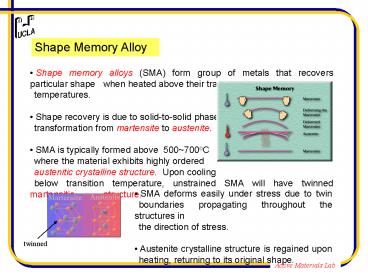Shape Memory Alloy PowerPoint PPT Presentation
Title: Shape Memory Alloy
1
Shape Memory Alloy
- Shape memory alloys (SMA) form group of metals
that recovers particular shape when heated above
their transformation - temperatures.
- Shape recovery is due to solid-to-solid phase
- transformation from martensite to austenite.
- SMA is typically formed above 500700oC
- where the material exhibits highly ordered
- austenitic crystalline structure. Upon cooling
- below transition temperature, unstrained SMA
will have twinned martensitic structure.
- SMA deforms easily under stress due to twin
boundaries propagating throughout the structures
in - the direction of stress.
- Austenite crystalline structure is regained upon
heating, returning to its original shape.
2
Shape Memory Alloy (cont.)
- Stress-strain curve for SMA has non-linearlity
referred as pseudoelasticity. - Pseudoelastic behavior causes SMA to strain up
to 68! - Mechanisms for pseudoelasticity involves either
twinning or stressed-induced martensitic
transformation (superelasticity) .
- Twinning pseudoelasticity caused by formation
of twins or by motion of twin boundaries.
- Superelasticity SMA in austentite phase
seemingly shows plastic deformation that is
fully recoverable when stress is removed.
Martensite reverts back to the austenite phase
providing the shape recovery.
3
Thin Film Shape Memory Alloy
- Drive to miniaturization forces attention to
sputter deposited thin film SMA for MEMS
applications. - Sputter deposition is performed in an ultra high
- vacuum (UHV) system.
- SMA thin films strongly depend on metallurgical
- factors and sputtering conditions.
- Sputtering involves ejection of particles by
momentum - transfer from a SMA target on to a substrate.
- Ejection of target particles is furnished by ion
- bombardment using argon gas flow (causes plasma).
PowerShow.com is a leading presentation sharing website. It has millions of presentations already uploaded and available with 1,000s more being uploaded by its users every day. Whatever your area of interest, here you’ll be able to find and view presentations you’ll love and possibly download. And, best of all, it is completely free and easy to use.
You might even have a presentation you’d like to share with others. If so, just upload it to PowerShow.com. We’ll convert it to an HTML5 slideshow that includes all the media types you’ve already added: audio, video, music, pictures, animations and transition effects. Then you can share it with your target audience as well as PowerShow.com’s millions of monthly visitors. And, again, it’s all free.
About the Developers
PowerShow.com is brought to you by CrystalGraphics, the award-winning developer and market-leading publisher of rich-media enhancement products for presentations. Our product offerings include millions of PowerPoint templates, diagrams, animated 3D characters and more.

